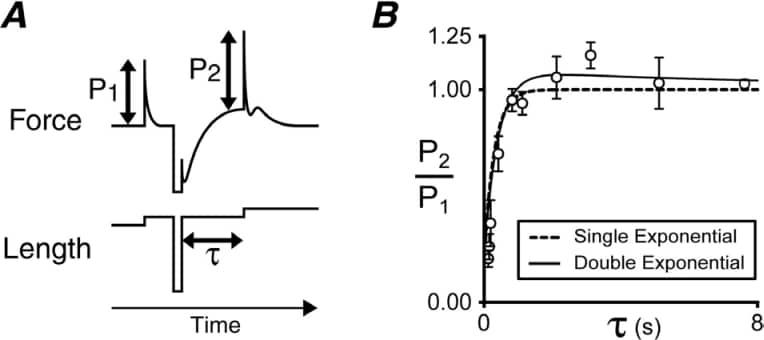When contracting muscle fibres are allowed to shorten and then rapidly re-stretched, tension often transiently exceeds the steady-state isometric level during the recovery process. The effect is particularly prominent in permeabilized muscle fibres at sub-maximal levels of Ca2+ activation. We have used stiffness measurements to investigate whether this tension overshoot may reflect a temporary increase in the number of attached cross-bridges.Bundles of soleus fibers were isolated from a rat (anaesthetized by inhalation of 3-4% isofluorane and subsequently killed by a pneumothorax) and skinned using 1% Triton X-100. Individual fibres (n=7, initial sarcomere length 2.55 ± 0.04 µm) were connected between a motor (Aurora 312B, step-time ~0.5 ms) and a force transducer (AE801, resonant frequency 2.5 kHz). Fibres were activated in solutions with pCa (= -log10[Ca2+]) values in the range 9.0 to 4.5. Once tension had stabilized in each solution, ten trials, each of the form shown schematically in Fig 1A were imposed at regular 18 s intervals. The fibre was subjected to two 1% length changes during each trial. A large shortening/re-stretch perturbation (20% muscle length, 20 ms duration) was applied 60 ms after the first length change. The time interval τ (Fig 1A) was adjusted between pre-set values in a pseudo-random manner in successive trials. The muscle was returned to its initial length at the end of each 8 s recording. Experiments were performed using SLControl software (Campbell & Moss, 2003).The P2/P1 ratio (Fig 1A) is a measure of the muscle’s relative stiffness. Fig 1B shows this ratio plotted as a function of the time interval τ at a sub-maximal level of Ca2+ activation. A double exponential function (which transiently exceeds unity) fits the experimental data significantly better (F-test, p<0.001) than a single exponential function (which approaches unity asymptotically).This result suggests that the number of attached cross-bridges temporarily exceeds the steady-state value following release and re-stretch of the muscle. Possible mechanisms include transient cooperative recruitment of new force-generating cross-bridges or a combination of new cross-bridge attachments at the longer lengths and slower detachment of cross-bridges strained by the stretch.
University of Glasgow (2004) J Physiol 557P, C21
Communications: Muscle stiffness transiently exceeds its steady-state value following a rapid shortening/re-stretch protocol
K.S. Campbell and R.L. Moss
Department of Physiology, University of Wisconsin-Madison, Madison, WI, USA
View other abstracts by:
All results are quoted as mean ± SD. Fig 1. A) Schematic diagram illustrating experimental protocol. B) Mean ± SD values of P2/P1 plotted as a function of the delay interval τ.pCa 5.9. Isometric tension was 0.57 ± 0.03 of maximum Ca2+ activated tension.
Where applicable, experiments conform with Society ethical requirements.

